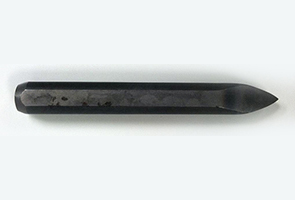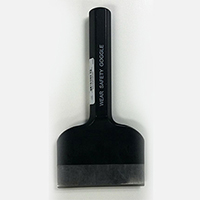Using a chisel with a cushioned grip can reduce the grip strength needed to hold the tool area. Some chisels, such as Stanley FatMax® Chisels*, come with a cushioned grip that can reduce vibration. Another option to reduce shock, vibration and overstrike injuries is to use a device that moves your hand away from the risk. The Trow & Holden Chisel Whizard*, for example, uses rubber loops to "firmly grip the tool handle but still allows you to adjust the blade angle..." The Whizard* has an 8" long handle with roughly a 4" grip and is available to fit chisel stock sizes ranging from 1/2" to 1-1/8".
Some chisels also come with hand guards, such as Stanley FatMax® Chisels*, or allow you to add a guard, such as the Trow and Holden Hand Shield,* which fits chisels with stocks (diameters) of 1" to 1-1/8".
Wearing gloves may also help create a cushion, increase the size of the handle area, and reduce shock and vibration. Depending on the materials and products you are working with a specific type of glove may be recommended or required to protect your hands from skin disorders, such as burns and dermatitis, or other injuries. Note: some workers have reported a reduced sense of touch and needing a stronger grip when wearing gloves. Using a tool with a non-slip grip area or adding an anti-slip material may help.
If you already have a hand/arm injury or condition such as tendonitis, arthritis, or carpal tunnel syndrome, it is particularly important to consider using the lightest, smallest chisel for the job and one with features that reduce vibration risks.
Example
Worker Hand Measurements = hand size (length from wrist crease to tip of middle finger) of about 7-1/4" (or 7.25"), with a grip diameter of about 1-2/5" (or 1.4"), a grip size of about 4-3/5" (or 4.6"), and a palm size of 3".
Choices:
A 3" brick chisel with a diameter or stock of 1.1", with a grip area of roughly 3-1/2", and weighing 1.1lb (or 17 oz).
Or
A 3" brick chisel with a striking cap and cushioned grip, a 1-3/8" diameter or stock a grip area of about 4-2/5" and weighing 1.6 lb (or 22 oz).
What the worker in this example should consider:
- The first option provides maximum visibility of the worker’s task and weighs less.
- The second option includes features that reduce the risk for injury including: a striking cap to reduce overstrike injuries and a cushioned grip, which increases the grip size to more closely match the worker’s and reduces the amount of strength needed to hold and control the chisel, the risk of vibration-related injuries, and exposure to cold.



